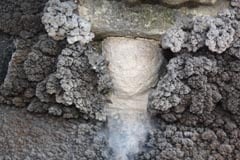Often, gentle abrasion with Restorative Techniques’ VorTech system or paint and hard grime removal using the company’s ThermaTech superheated steam system are just the right solution for cleaning stone. But not always. Sometimes chemical answers are required and when they are, Restorative Techniques can supply them.
Restorative Techniques’ range of chemical products and poultices has expanded widely over the past year, with a number of useful new products being added.
Many will already be familiar with the company’s broad spectrum of popular products, from paint softeners though to Latex-type ‘peel-off’ poultices and ready-to-use activated clay-based metallic stain removal products. Specifiers particularly appreciate them being supplied with technical support and knowledge, which can be useful when tackling the removal of applied finishes (such as graffiti) from easily damaged substrates.
Too often graffiti has been inappropriately removed, leaving a surface permanently displaying the scarring or ‘ghosting’ of removal.
One of Restorative Techniques most popular products is called Restorative Latex Poultice Cleaner. It is supplied in a variety of strengths to enable the most suitable formulation for the task in hand to be selected, paying due consideration to the substrate.
Restorative Latex Poultice Cleaner is highly effective at cleaning large areas of internal surfaces with minimal disruption and use of manpower. It is simply applied then left to cure to a rubberised film that is simply peeled away, bringing the dirt with it. Many large projects have been undertaken in this way with only a handful of operatives.
This product has always worked well on internal surfaces, but sometimes where there has been long-term water ingress or high levels of condensation, the latex can struggle.
A new product has been developed by Restorative Techniques for just such situations. It is called Restorative Complex Paste. It is an EDTA-based sequestering agent that is a powerful general cleaner as well as being particularly good at drawing out certain stains. It has quickly become popular with contractors, who often order quantities of both the ‘Latex’ and the ‘Complex’ products when they are faced with internal cleaning projects.
As this new Restorative Complex Paste is effective on damp areas, it can also be useful on external surfaces to tackle ingrained staining – such as can be seen in some types of stone around leadwork.
Restorative Techniques offer a range of poultices for tackling the wide range of staining and discolouration problems that masons face when trying to clean old masonry.
Limestone is attacked by acidic sulphurous gases in the air – present as a result of burning fossil fuels such as coal and petrol. The resulting calcium sulphate and carbon particulates bind to sheltered areas of affected masonry and carbon sulphation can accumulate. Sometimes it is just a few microns thick and sometimes it forms a ‘clinker’ of several centimetres.
This deposit, if left entirely untouched, can be extremely damaging to limestone. The use of an Ammonium Carbonate poultice, mixed from the poultice components that Restorative Techniques supply, can remove such accumulations – although such poultices should only be used by those who know what they are doing.
The raw components of the poultices are normally supplied dry, which means nobody is paying for water to be transported. Water is added on-site after the components have been mixed together. The poultice is applied to the surface to be cleaned and after it has done its job, the surface can be rinsed using the ThermaTech superheated water system.

